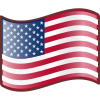
El Salvador, officially the Republic of El Salvador, is a country in Central America. It is bordered on the northeast by Honduras, on the northwest by Guatemala, and on the south by the Pacific Ocean. El Salvador's capital and largest city is San Salvador. The country's population in 2024 was estimated to be 6 million according to a government census.

This is a demography of the population of El Salvador including population density, ethnicity, education level, health of the populace, economic status, religious affiliations and other aspects of the population.
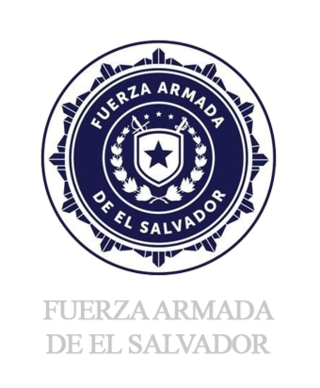
The Armed Forces of El Salvador are the official governmental military forces of El Salvador. The Forces have three branches: the Salvadoran Army, the Salvadoran Air Force and the Navy of El Salvador.
The history of El Salvador begins with several distinct groups of Mesoamerican people, especially the Pipil, the Lenca and the Maya. In the early 16th century, the Spanish Empire conquered the territory, incorporating it into the Viceroyalty of New Spain ruled from Mexico City. In 1821, El Salvador achieved independence from Spain as part of the First Mexican Empire, only to further secede as part of the Federal Republic of Central America two years later. Upon the republic's independence in 1841, El Salvador became a sovereign state until forming a short-lived union with Honduras and Nicaragua called the Greater Republic of Central America, which lasted from 1895 to 1898.

The 18th Street Gang, also known as Eighteen St, Barrio 18, Mara 18, or simply 18 in North America, is a multi-ethnic transnational criminal organization that started as a street gang in Los Angeles. It is one of the largest transnational criminal gangs in Los Angeles, with 30,000-50,000 members between the United States, Mexico, and Central America and is also allied with the Mexican Mafia, another US-based crime organization. A United States Department of Justice report featured the following statement regarding 18th Street and rival gang MS-13, "These two gangs have turned the Central American northern triangle into the area with the highest homicide rate in the world."

The Farabundo Martí National Liberation Front is a Salvadoran political party and former guerrilla rebel group.
A mara is a form of gang originating in the United States, which spread to Central American countries such as El Salvador, Honduras and Guatemala.
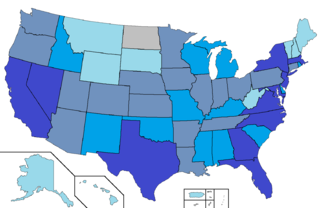
Salvadoran Americans are Americans of full or partial Salvadoran descent. As of 2021, there are 2,473,947 Salvadoran Americans in the United States, the third-largest Hispanic community by nation of ancestry. According to the Census Bureau, in 2021 Salvadorans made up 4.0% of the total Hispanic population in the United States.

Carlos Mauricio Funes Cartagena is a Salvadoran politician and former journalist who served as the 41st President of El Salvador from 2009 to 2014. Funes won the 2009 presidential election as the candidate of the left-wing Farabundo Martí National Liberation Front (FMLN) party and took office on 1 June 2009. Since 2016, Funes and his immediate family have been living in exile in Nicaragua due to allegations of criminality during his tenure. In July 2023, he was placed under sanctions by the U.S. State Department due to his conviction in absentia for negotiations related to the gang truces he made while in office, illicit enrichment, and tax evasion.
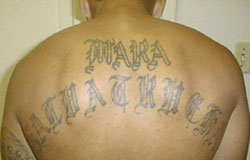
Mara Salvatrucha, commonly known as MS-13, is an international criminal gang that originated in Los Angeles, California, in the 1980s. Originally, the gang was set up to protect Salvadoran immigrants from other gangs in the Los Angeles area. Over time, the gang grew into a more traditional criminal organization. MS-13 has a longtime rivalry with the 18th Street gang.
The Central American Resource Center (CARECEN) are two community-based organizations that seek to foster the comprehensive development of the Latino community. CARECEN in the Washington, D.C. metropolitan region was founded in 1981 to protect the rights of refugees arriving from conflict in Central America and to help ease their transition by providing legal services. CARECEN provides direct services in immigration, housing and citizenship while also promoting empowerment, civil rights advocacy and civic training for Latinos. Another CARECEN is also located in Los Angeles and which was established two years after the D.C. location.

Crime in El Salvador has been historically extremely high due to the presence of various gangs. As of 2011, there were an estimated 25000 gang members at large in El Salvador; with another 43500 in prison. The best-known gangs, called maras in colloquial Salvadoran Spanish, are Mara Salvatrucha (MS-13) and their rivals 18th Street; maras are hunted by death squads, including Sombra Negra. Newer rivals include the rising mara, The Rebels 13. El Salvador is one of the three countries of the Northern Triangle of Central America, along with neighboring Guatemala and Honduras, which are all afflicted with high levels of violence.
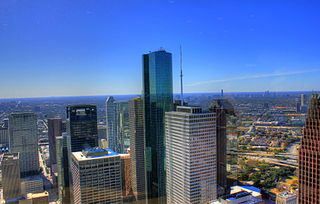
The City of Houston includes a significant population of Central American origin due to Texas' proximity to Central America, including origins from El Salvador, Guatemala, Honduras, and other countries.
The City of Los Angeles includes a prominent Central American population. As of 2010 it is the second largest Latino and Hispanic ethnic group in Los Angeles after Mexican-Americans. The largest Central American groups were Guatemalans, Hondurans and Salvadorans.

The 2014 American immigration crisis was a surge in unaccompanied children and women from the Northern Triangle of Central America (NTCA) seeking entrance to the United States in 2014. According to U.S. law, an unaccompanied alien child refers to a person under 18 years of age, who has no lawful immigration status in the U.S., and who does not have a legal guardian to provide physical custody and care.
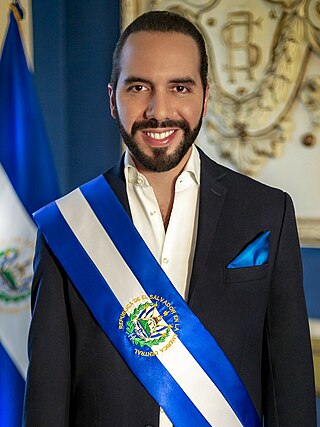
Nayib Armando Bukele Ortez is a Salvadoran politician and businessman who, since 1 June 2019, has been the 81st president of El Salvador. As a member of the Nuevas Ideas political party, Bukele is the first Salvadoran president since 1989 who was not elected as a candidate of one of the country's two major political parties: the right-wing Nationalist Republican Alliance (ARENA) or the left-wing Farabundo Martí National Liberation Front (FMLN), of which Bukele had previously been a member.
Palestinian Salvadorans (Spanish: Salvadoreños Palestinos; Arabic: فلسطينيو السلفادور), are Salvadoran citizens of Palestinian descent or Palestine-born people residing in El Salvador. There are approximately 100,000 Salvadorans with Palestinian ancestry.
La Mano Dura is a set of tough-on-crime policies put in place by Latin American governments in response to the problem of gang violence, organized crime and insecurity. These policies were put in place in response to popular calls for the government to do something about the problem of rampant crime. La Mano Dura policies have come under criticism due to human rights concerns.

The Northern American Triangle refers to the Central American countries of El Salvador, Guatemala, and Honduras.
El Rescate is a nonprofit resource center and community organization based in Southern California providing free legal and social services to Central American refugees living primarily in Los Angeles and surrounding communities.


